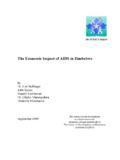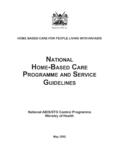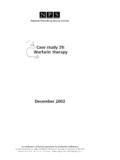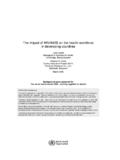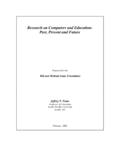Transcription of The Economic Impact of AIDS - POLICY Project
1 The Economic Impact of aids by John Stover Lori Bollinger March 1999 The Futures Group International in collaboration with: Research Triangle Institute (RTI) The Centre for Development and Population Activities (CEDPA) The POLICY Project POLICY is a five-year Project funded by the Agency for International Development under Contract No. CCP-C-00-95-00023-04, beginning September 1, 1995. The Project is implemented by The Futures Group International in collaboration with Research Triangle Institute (RTI) and The Centre for Development and Population Activities (CEDPA). 3 aids has the potential to create severe Economic impacts in many African countries. It is different from most other diseases because it strikes people in the most productive age groups and is essentially 100 percent fatal. The effects will vary according to the severity of the aids epidemic and the structure of the national economies.
2 The two major Economic effects are a reduction in the labor supply and increased costs: Labor Supply The loss of young adults in their most productive years will affect overall Economic output If aids is more prevalent among the Economic elite, then the Impact may be much larger than the absolute number of aids deaths indicates Costs The direct costs of aids include expenditures for medical care, drugs, and funeral expenses Indirect costs include lost time due to illness, recruitment and training costs to replace workers, and care of orphans If costs are financed out of savings, then the reduction in investment could lead to a significant reduction in Economic growth A World Bank study of the Economic impacts of aids in Africa concluded that the macroeconomic impacts of aids could be Yet there is still time to mitigate the Economic Impact of aids ; over half of Africa s population live in countries where the epidemic is concentrated, that is, where HIV infection is concentrated in groups with risky behavior and is not yet widespread in the general The Economic effects of aids will be felt first by individuals and their families, then ripple outwards to firms and businesses and the macro-economy.
3 This paper will consider each of these levels in turn and provide examples from various African countries to illustrate these impacts. Economic Impact of aids on HouseholdsEconomic Impact of aids on Households The household impacts begin as soon as a member of the household starts to suffer from HIV-related illnesses: Loss of income of the patient (who is frequently the main breadwinner) Household expenditures for medical expenses may increase substantially Other members of the household, usually daughters and wives, may miss school or work less in order to care for the sick person Death results in: a permanent loss of income, from less labor on the farm or from lower remittances; funeral and mourning costs; and the removal of children from school in order to save on educational expenses and increase household labor, resulting in a severe loss of future earning potential. 4 Studies in Tanzania, Cote d Ivoire, Uganda, and Ethiopia have documented the tremendous burden of loss of income, large health care expenditures, and consumption of savings to pay for funeral and mourning costs: In Tanzania, a study of adult mortality found that 8 percent of total household expenditure went to medical care and funerals in households that had an adult death in the preceding 12 months.
4 In households with no adult death the figure was only percent. In addition to increased expenditures, many households experienced a reduction in remittances if the adult member worked outside the home. In partial compensation for these financial setbacks, many households were forced to remove children from school in order to reduce education-related expenditures and have the children help with household In Cote d Ivoire, households with an HIV/ aids patient spent twice as much on medical expenses as other households. Furthermore, 80 percent of the expenditures went to the aids patient, rather than to other household members who are ill. When the person with aids died or moved away, average consumption fell by as much as 44 percent during the following In Uganda, the Economic Impact of HIV-related deaths was stronger than other types of death, as households lost much of their savings in order to pay health care and funeral expenditures.
5 Asset ownership declined when the death of an HIV+ member occured, but remained stable when the death was of an HIV- In Ethiopia, a study of 25 aids -afflicted rural families found that the average cost of treatment, funeral and mourning expenses amounted to several times the average household Economic Impact of aids on AgricultureEconomic Impact of aids on Agriculture Agriculture is the largest sector in most African economies accounting for a large portion of production and a majority of employment. Studies done in Tanzania and other countries have shown that aids will have adverse effects on agriculture, including loss of labor supply and remittance income. The loss of a few workers at the crucial periods of planting and harvesting can significantly reduce the size of the harvest. In countries where food security has been a continuous issue because of drought, any declines in household production can have serious consequences.
6 Additionally, a loss of agricultural Funeral and Health Care Expenditures Increase When an Adult in the Household Dies05101520253035No aids DeathAIDS DeathPercent of Household ExpenditureFuneralsHealth Care 5labor is likely to cause farmers to switch to less-labor-intensive crops. In many cases this may mean switching from export crops to food Thus, aids could affect the production of cash crops as well as food crops. A study done by the Zimbabwe Farmers Union (ZFU) showed that the death of a breadwinner due to aids will cut the marketed output of maize in small scale farming and communal areas by 61 percent. Similar results were obtained for other crops (see table at right). The fall in marketed output results from losses of labor and remittances and the need to spend scarce resources on medical In Ethiopia, the male head of the household is responsible for special tasks, such as oxen cultivation, harvesting, threshing and farm management.
7 One study found that the effect of an aids death varied by region: it would have the most severe effect on harvesting teff in Nazareth, on digging holes for transplanting enset plants in Atat, on ploughing millet fields in Baherdar, and on picking coffee in Yirgalem. Women are generally responsible for other tasks: leveling, weeding, harvesting minor crops, transporting produce, and household duties. The death of the wife to aids can make it difficult for other household members to carry out these tasks, in addition to caring for children. The death of a family member because of aids also leads to a reduction in savings and investment. The stock of food grain can be depleted to provide food for mourners and the other expenses were met most often by selling livestock. Such loss of productive assets only makes it harder to survive in the In Kagabiro village, TanzaniaTanzania, when a household contained an aids patient, the household labor supply was severely affected: on average, 29% of household labor was spent on aids -related matters, including care of the patient and funeral duties.
8 If two people were devoted to nursing duties, as occurred in 66% of the cases, the total labor loss was 43%, on In Malawi, 10% of GDP comes from estate agriculture. A recent study evaluated the costs of HIV/ aids on a tea estate there (see table at right). The study found that the costs are determined by the levels of both employee benefits and of skilled labor necessary for production. It predicted that, in the longer term, the negative Impact on the supply Reduction in Marketed Output Due to aids Deaths in Zimbabwe Crops Reduction in Marketed Output Maize 61% Cotton 47% Vegetables 49% Groundnuts 37% Cattle Owned 29% Cost of HIV/ aids on a Tea Estate in Malawi Description Total Cost ( ) Related to HIV ( % ) Cost of HIV ( ) Provision of medical services 22,275 25 5,569 Funeral costs 928 75 696 Death in service benefits 4,691 100 4,691 Absence 14,875 25 3,719 Total 42,769 14,675 6of skilled labor will be the strongest effect of It will become increasingly difficult to recruit skilled people, even at the national level.
9 Data collected in Uganda indicate that agricultural tasks were frequently disrupted when women needed to care for household members ill with aids -related Economic Impact of aids on FirmsEconomic Impact of aids on Firms aids may have a significant Impact on some firms. aids -related illnesses and deaths to employees affect a firm by both increasing expenditures and reducing revenues. Expenditures are increased for health care costs, burial fees and training and recruitment of replacement employees. Revenues may be decreased because of absenteeism due to illness or attendance at funerals and time spent on training. Labor turnover can lead to a less experienced labor force that is less productive. Factors Leading to Increased Expenditure Factors Leading to Decreased Revenue Health care costs Absenteeism due to illness Burial fees Time off to attend funerals Training and recruitment Time spent on training Labor turnover The actual distribution of these costs has been calculated as part of various USAID-funded AIDSCAP studies of the private sector Impact of aids : One study examining several firms in Botswana and Kenya showed that the most significant factors in increased labor costs were absenteeism due to HIV or aids and increased burial costs as shown in the figure to the Another study in Zimbabwe found that the major expense was health care costs.
10 The transport company in this study has a large staff of 11,500 workers. Since the company offers significant health benefits to its employees, the cost of aids is even higher than for other companies that do not provide such benefits. The study estimated that there are currently more than 3,400 workers who are infected with HIV and 64 who died from aids in 1996. The total costs of aids to the company in 1996 were estimated at Z$39 million, equal to about 20 percent of the company's profits. More than half of this amount resulted from increased health care costs. By 2005 the cost of aids to Distribution of Increased Labour Costs Due to HIV/ aids in in Selected Firms in Kenya and BotswanaRecruitment9%Health Care5%Burial16%HIV Absenteeism37% aids Absenteeism15%Funeral Attendance6%Labour Turnover5%Training7% 7the company could reach Z$108 million. There may be indirect costs as well. The report speculates that HIV/ aids will worsen employee morale and create greater labor-management tensions and cause a labor shortage among skilled Various studies have also examined the total annual cost of aids to different companies, as well as the annual cost of aids per These studies found that the annual cost of aids per employee varied from US$17 to US$300, as shown in the table below.
